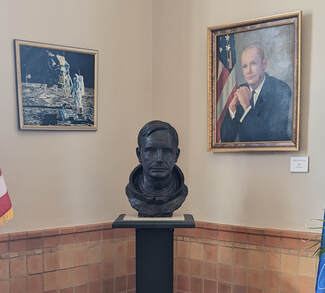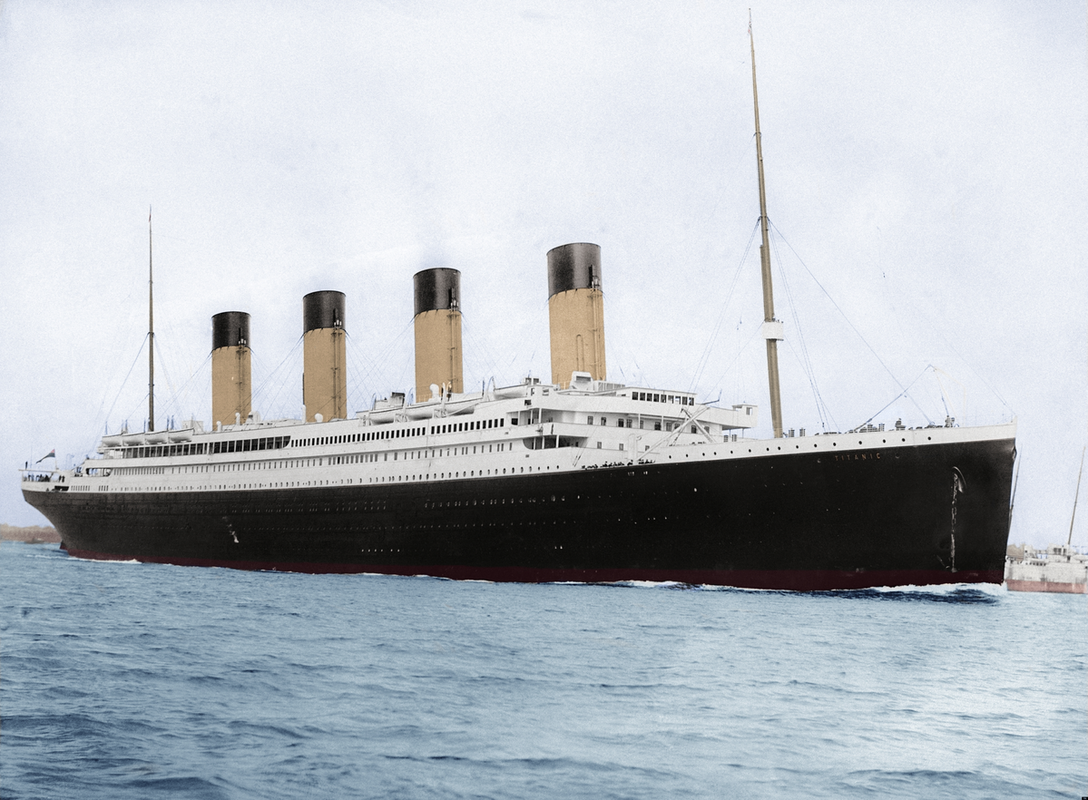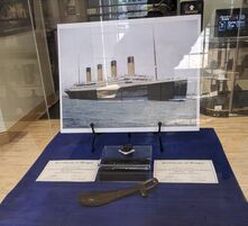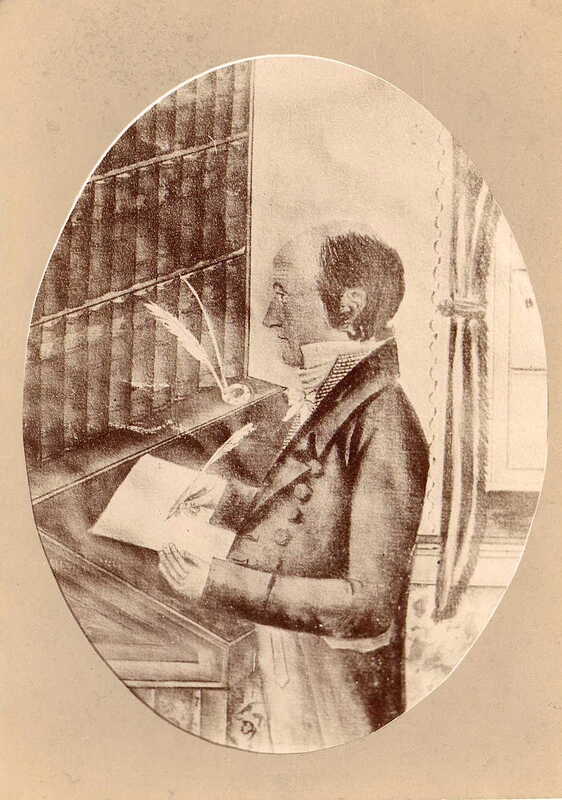|
Donna Summers, Armstrong Gallery Curator  The Armstrong Gallery of Flight is now a part of the Ohio Aviation trail. When visiting the Armstrong Gallery of Flight, one of the first things guests notice is the mural that dominates the north wall. Created by Carol Ann Newsome, it depicts early Warren County aviators Clifford Harmon and Lincoln Beachey around 1909. Lebanon residents William and Clifford Harmon were fourth cousins to the Wright Brothers. Clifford achieved a number of aviation firsts, including being the first person to fly across Long Island Sound and the first aviator to carry a female passenger (his wife). In 1910, he became the sixth person in the U.S. to receive a pilot’s license. In 1926, Clifford sponsored the Harmon Trophy for outstanding aviators, aviatrix, and aeronauts (balloons or dirigibles). In 1969, a category for astronauts was added. Neil Armstrong received the prestigious award. Daredevil, stunt pilot and “America’s greatest aerial exhibitionist”, Lincoln Beachy, also grew up in Lebanon, Ohio. In 1900, when Beachy was 13, like the Wright Brothers, Lincoln and his brother Hillary opened a bicycle shop. Beachy earned his pilot’s license when he was 24; he was the 26th person to do so. He virtually invented aerobatics and was known as “The Man Who Owns the Sky.” Beachy often teamed up with race car driver, Barney Oldfield, and staged races. The two thrilled audiences around the country as Beachey’s bi-plane roared around a track in hot pursuit of Oldfield in his car. In one year alone, an estimated 17 million people, one-sixth of the U.S. population, saw Lincoln Beachey fly. In Warren County, new airports came from an unexpected source: farmers. Farmers nationwide saw the airplane as a new farm implement necessary to farm operations. Landings strips began to appear on farms nationwide. Aided by the Flying Farmers Association, local farmers changed the face of Warren County. Warren County Airport/John Lane Field began as a grass strip. John, an avid pilot, had courted his wife, Joann by flying her to a pasture near her home in Waynesville. After the two were married, they purchased a farm near Lebanon. They created an airstrip by mowing a north-south runway between their fields. As members of the Flying Farmers Association, the Lanes welcomed pilots from all over the United States to Warren County. In 1964, Ohio Governor James Rhodes decreed that there should be a paved runway in every county in the state. John Lane worked with Warren County officials to pave and light his airstrip. A second grass airstrip, the Red Stewart Airfield, was started in the 1950s. Red Stewart would fly his Piper Cub to work and land in the parking lot of Frigidaire Appliance factory in Dayton, Ohio. Eventually, when the Frigidaire plant manager told Stewart to stop flying his plane to work, Stewart quit his job and created an airfield on a 108-acre farm two-miles south of Waynesville, Ohio. It continues operations under the guidance of fourth generation family members. In 1960, a third farm airstrip was created south of Lebanon, Ohio. Brownies Airport, named after one of its owners, hosted a skydiving club and offered flying lessons. On July 20, 1969, Neil Armstrong, engineer, fighter pilot, test pilot, and Gemini and Apollo astronaut, stepped onto the moon’s surface. Armstrong’s moon walk lasted 2 hours and 13 minutes. Upon his return to earth, Armstrong stayed with NASA until 1971. Then he joined the faculty at the University of Cincinnati, School of Engineering and moved to Warren County. For 23 years, Warren County’s most famous resident, Neil Armstrong, and his wife, Jan, lived and raised their family on a farm less than two miles from downtown Lebanon. He was active in the community, serving on several boards, including the YMCA and United Way. Upon his passing, the Harmon Museum received many items from his estate including a gold plated frisbee from Whamo and a bronze bust of Armstrong.
0 Comments
The RMS Titanic struck an iceberg late April 14, 1912 and sunk, in the early morning hours, April 15. An estimated 1514 lives were lost.
These Titanic artifacts are currently on loan. The small black rock is a piece of coal. The metallic spoon shaped object is a shoehorn provided in first class. by John Zimkus, Historian /Education Director of the Harmon Museum
excerpt featured in the Spring 2024 Medallion Newsletter In the late 1920s, when a young Bob Jones purchased the Lebanon Hotel, the old Lebanon House, he had several goals for the old inn. One of them was to restore to the hotel its historic name - The Golden Lamb. Another was to make it a destination restaurant, one that had a strong enough appeal to draw customers from beyond Lebanon, Ohio and the surrounding area. He succeeded with both goals. 100 years earlier, in the 1820s, another innkeeper attempted to make The Golden Lamb the 19th century equivalent of a destination restaurant. His name was Henry Share. Share was born Henrich Sherr in 1763 in the colony of Pennsylvania. In 1820, he and his second wife Mary, also known as Polly, took over the management of The Golden Lamb in Lebanon. The hotel at that time was only about a quarter of the size it is today. Two stories high, it was basically what is covered by The Golden Lamb’s present porch— the lobby, the Dickens Dining Room, the Lebanon Room and the guest rooms on the second floor. It didn’t take long for The Golden Lamb, under Henry Share’s guidance, to be known for its fine food. Henry Share, apparently, was not satisfied with such glowing reviews. He wanted to increase business at his Golden Lamb even more. To him, the answer was theatrical and sideshow attractions. On April 10, 1830, The Western Star newspaper announced: “EGYPTIAN MUMMY To be exhibited for a few days only in the new frame building on the public square, near Mr. Share’s Hotel – commencing on Saturday the 10th inst. There is nothing upon which the living eye can rest more impressive and interesting than the preserved mortal remains of human beings who were inhabitants of earth more than 3,000 years ago. Such are the Egyptian Mummies, embalmed, bandaged, encased, and preserved in excavated recesses of everlasting rock. This mummy was brought to this country by Captain Turner of Charlestown, Mass. from Trieste, at which place it had been received from Thebes. It is very perfect; retaining all its form and features. It stands in the back part of the coffin, wrapped with numerous thickness of the twined linen of Egypt, mentioned in the Scriptures. The envelope is removed from the face, hands and feet. It is of dark color, derived from the embalming material, and not the original color, as the hair is sandy and straight. The coffin is said to be of sycamore wood, covered with Egyptian cement. On the front or lid are various hieroglyphics, supposed to be a biographical account of the deceased person, who according to history, must have lived on this earth 3,000 years ago. The proprietor flatters himself, that no person who has not seen a Mummy, will let this pass without viewing it. Admittance 12 ½ cents.” Captain Larkin Turner brought the Egyptian mummy to the United States in 1824 on his ship Caroline Augusta. Shortly after landing in America, he sold it to Ethan Allen Greenwood, a lawyer and proprietor of the New England Museum in Boston. Greenwood lost no time in sending this new mummy on tour throughout New England in 1824 and to Ohio by 1830. The mummy was brought to the US from Trieste, a city and seaport lying between the Adriatic Sea and Italy's border with Slovenia. In 1830, the time of this ad, Trieste was a prosperous seaport in the Mediterranean region, and the fourth largest city of the Austro-Hungarian Empire. With the collapse of the Empire after World War I, Trieste was annexed to Italy. The mummy came to Trieste from “Thebes,” which is the Greek name of Ancient Egyptian city of Waset. It was located along the Nile River about 500 miles south of the Mediterranean Sea. Thebes (Waset) was the capital of Egypt for long periods during the Middle Kingdom and New Kingdom eras. Thebes’ ruins lie within the modern Egyptian city of Luxor. “12 ½ cents” at this time was called a “bit” equal to one-eighth of a dollar, as in a 25-cent piece, or quarter, being “2 bits.” During the colonial period, the most common unit of currency used in the American Colonies was in fact the Spanish dollar, also known as "piece of eight.” It was worth 8 Spanish silver reales. Spanish coinage, and other foreign coins, continued to be widely used and allowed as legal tender in the United States until the Coinage Act of 1857 was passed by the US Congress. It discontinued the practice repealing all acts "authorizing the currency of foreign gold or silver coins.” 12 ½ cents in 1830, adjusted for inflation, has a value of $3.36 today. Henry Share was perhaps proudest of the fare his Golden Lamb offered. In 1827, he advertised in various newspapers within 100 miles of Lebanon, that the improvements to his “Ohio and Pennsylvania Hotel, SIGN OF THE GOLDEN LAMB” are “not excelled by many in the west, where Ladies and Gentlemen who may think proper to favor him with call, will find good accommodation; he will endeavor by diligent attention to provide his table with the best the country affords, and his bar with the choicest liquors.” Today’s Golden Lamb pledges to its patrons many of the same fine amenities Henry Share’s inn did 200 years ago . . . minus the occasional mummy. |
AuthorVarious staff and volunteer writers. Categories
All
Archives
June 2024
|
Email: [email protected]
Wchs Office/Harmon MuseumTues - Sat: 10am - 4pm
Year Round |
1795 BEEDLE cABINPhone for hours
Year Round |




 RSS Feed
RSS Feed





